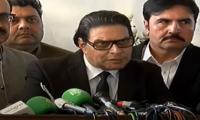Imran Khan and his political cousin, Dr Tahir-ul-Qadri, “publicly” met in Lahore on Thursday after a gap of three years and 12 days or 1,107 days to be more precise.
The word "publicly" has been written in inverted comas because between September 2014 and September 2017, rumours and unconfirmed media reports have surfaced once or twice, whereby it was stated that Imran and Qadri have met secretly and away from the public eye outside the country. Prompt denials had followed from both camps though.
On Thursday (yesterday), the Pakistan Awami Tehreek (PAT) chief Tahir-ul-Qadri had gone on to announce his party’s support for Pakistan Tehreek-e-Insaaf (PTI)’s candidate Dr. Yasmin Rashid in Lahore’s NA-120 by-polls that are due to be held in a couple of days’ time on September 17.
The last time Imran and Qadri were seen together by the public was on September 2, 2014, when PTI and PAT had officially joined hands in Islamabad during their eventful 126-day long sit-in against the Nawaz regime.
Qadri had then stepped up Imran’s Khan’s lavish bullet-poof container to face television cameras and express solidarity with him. This was the day when a joint session of the Pakistani Parliament had seen all national political parties put aside their differences to stand against what they termed were attempts to derail the democratic process.
September 2, 2014 was also incidentally the day when the then PTI President, Javed Hashmi, had announced his resignation from the National Assembly to embrace his former party leader and the then incumbent Premier Nawaz Sharif.
A section of the Press had quoted Hashmi as saying:“We bow our heads in shame over the past 66 years of independence. Constitution of the 1954 was the best constitution of the country. Only Parliamentary system can save the country and I promised to serve my country. Prime Minister Nawaz Sharif failed to address public problems in last 30 years.”
The “Reuters” news agency had reported: “Members of Pakistan’s Parliament, representing several different political parties that don’t always see eye to eye, came together to express support for embattled Prime Minister Nawaz Sharif in a joint session convened. The session, which the Prime Minister’s Office reportedly said would continue until the end of the week, comes after more than two weeks of protests championed by former national cricket captain Imran Khan and firebrand cleric Muhammad Tahir-ul-Qadri that have convulsed the capital, Islamabad. Khan and Qadri allege that the country’s historic 2013 election was rigged, and say they will not back down until the Sharif resigns. Interior Minister Chaudhry Nisar called the ongoing protests a “rebellion against Pakistan.”
The joint session of the Pakistani parliament was held a day after charged protesters of PTI and PAT had forcibly entered the headquarters of the state TV building in Islamabad. As soon as angry protesters entered the news headquarters of the state-owned television channel, they had taken over the programming control room and transmission was taken off air temporarily, only to be restored after the Army had to step in to control the unruly mob.
And this particular event of PTI and PAT stalwarts storming into the state TV headquarters had taken place just two days after Imran Khan and Tahirul Qadri had met the then army chief Gen Raheel Sharif, amid growing political crisis that had prompted the Nawaz government to seek army's help.
Earlier in their speeches before the meeting, Imran Khan and Qadri had gone on to state they had accepted the role of the army chief as a mediator and guarantor in the political impasse that was haunting the Nawaz government those days.
On September 10, 2014, the Lahore Chamber of Commerce and Industry had revealed that the federal administration had confiscated almost 2,000 private consignment containers in Rawalpindi and Islamabad to block the PTI and PTI protestors.
It is imperative to note that the “political romance” between Imran Khan and Tahirul Qadri was rather short-lived, as on November 18, 2014, the PAT Chairman had publicly held his party had no relation with the PTI as both the parties had different programmes and political agendas to toe.
Qadri had asserted: “Those who are part of status quo and involved in corruption could not become our allies.” And then on October 24, 2016, Qadri had taken a U-turn by announcing to join Imran Khan in the latter’s quest to lockdown Islamabad on November 2, 2016 — something that never actually happened as the former cricket captain had decided against it at the eleventh hour despite skirmishes between his loyalists and the local police.
On October 24, 2016, Imran Khan had reportedly spoken to Qadri on telephone, and welcomed his former ally’s decision to join the anti-government protest planned for November 2, 2016. Qadri was in Jordan then.
The PTI protest date was changed from October 30 to November 2 as the Supreme Court Bar Association’s elections were scheduled on October 31 of the same year.
Earlier on August 30, 2016, the Pakistani Supreme Court had turned down a petition of Pakistan Tehreek-e-Insaaf chief Imran Khan to disqualify the then sitting Prime Minister Nawaz Sharif over Panama Papers leaks, saying the petitioner had not approached any other appropriate forum available.
In a constitutional petition filed by PTI lawyer Naeem Bokhari, Imran had sought the then Premier’s disqualification, his son-in-law Captain (retd) Safdar and Finance Minister Ishaq Dar from National Assembly seats.
Many political analysts say it was surprising that in less than two months’ time, on October 20, 2016, the same Supreme Court had accepted PTI’s petition to disqualify Nawaz Sharif.
We all know that the Panama Papers case or the Panamagate case was heard by the Supreme Court of Pakistan on a day-to-day basis between November 1, 2016 and 23 February 23, 2017, ultimately leading to the disqualification of Premier Nawaz Sharif on July 28, 2017.
This image shows a Rawalpindi Police official interacting with his juniors on November 30, 2023. —...
View of a China-Pakistan B2B Conference focusing on animal feed, fruit and vegetable processing industries hosted by...
CDA workers are cleaning an area following the PTI protest in Islamabad on November 27, 2024. — APPIslamabad :...
Muslim pilgrims circle the Kaaba as they pray at the Grand Mosque, during the annual haj pilgrimage in the holy city...
This representational image shows buses and other public transport vehicles filled with passengers. —...
Pakistan Medical and Dental Council building can be seen in this image. — PMDC website/FileIslamabad : The MDCAT...







